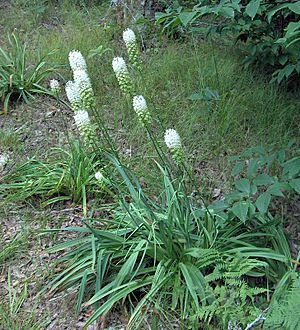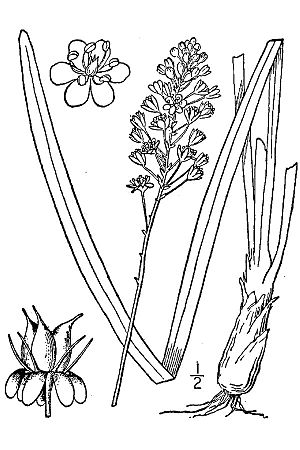Fly poison facts for kids
Quick facts for kids Fly poison |
|
|---|---|
 |
|
| in Great Smoky Mountains National Park | |
| Scientific classification | |
| Genus: |
Amianthium
|
| Species: |
muscitoxicum
|
| Synonyms | |
|
Synonymy
Amianthium muscaetoxicum, common misspelling
Melanthium muscaetoxicum Walter Melanthium muscitoxicum Walter Zigadenus muscitoxicum (Walter) Regel Chrosperma muscitoxicum (Walter) Kuntze Chrysosperma muscatoxicum (Walter) Kuntze Melanthium laetum Aiton. Anthericum subtrigynum Jacq. Melanthium myoctonum J.F.Gmel. Melanthium phalangioides Desr. Helonias erythrosperma Michx. Helonias laeta (Aiton) Ker Gawl. Leimanthium laetum (Aiton) Willd. Leimanthium pallidum Willd. Chrosperma laetum (Aiton) Raf. Amianthium macrotox Raf. Crosperma laeta (Aiton) Raf. Crosperma phalangioides (Desr.) Raf. |
|
Amianthium is a plant that grows in North America. It is a perennial plant, which means it lives for more than two years. This plant grows from special underground parts called bulbs.
The most well-known type of Amianthium is called Amianthium muscitoxicum. People often call it fly poison in English. This name comes from its Latin scientific name, muscitoxicum, which literally means "fly poison." The plant is known for its pretty flowers, but it also contains natural chemicals that make it very poisonous.
Contents
Why is it called Fly Poison?
All parts of the fly poison plant are toxic, especially its bulb. Long ago, American colonists discovered this. They would mix the plant's bulb with sugar. This mixture was then used to kill flies.
What Makes it Poisonous?
The fly poison plant contains special chemicals called alkaloids. These are natural compounds that can be harmful. Some of the alkaloids found in the roots and leaves of this plant include jervine and amianthine. Because of these chemicals, it is very important not to touch or eat any part of this plant.
Where Does Fly Poison Grow?
This plant is native to the eastern parts of North America. You can find it as far north as Pennsylvania. It grows west, generally near the Appalachian Mountains. There is also another area where it grows in the Ozarks. Southward, it can be found in northern Florida and eastern Louisiana.
How Does it Reproduce?
Fly poison plants cannot pollinate themselves. This means they need help from other plants or creatures to make seeds. Most often, beetles help to pollinate these plants. They carry pollen from one flower to another, allowing the plants to reproduce.
Fly Poison in the Plant Family Tree
The fly poison plant belongs to a plant family called Melanthiaceae. Scientists study how plants are related to each other. Sometimes, Amianthium muscitoxicum was thought to be part of a different group called Zigadenus. However, after more studies, scientists now agree that Amianthium is its own unique group of plants.
See also
 In Spanish: Amianthium muscitoxicum para niños
In Spanish: Amianthium muscitoxicum para niños


